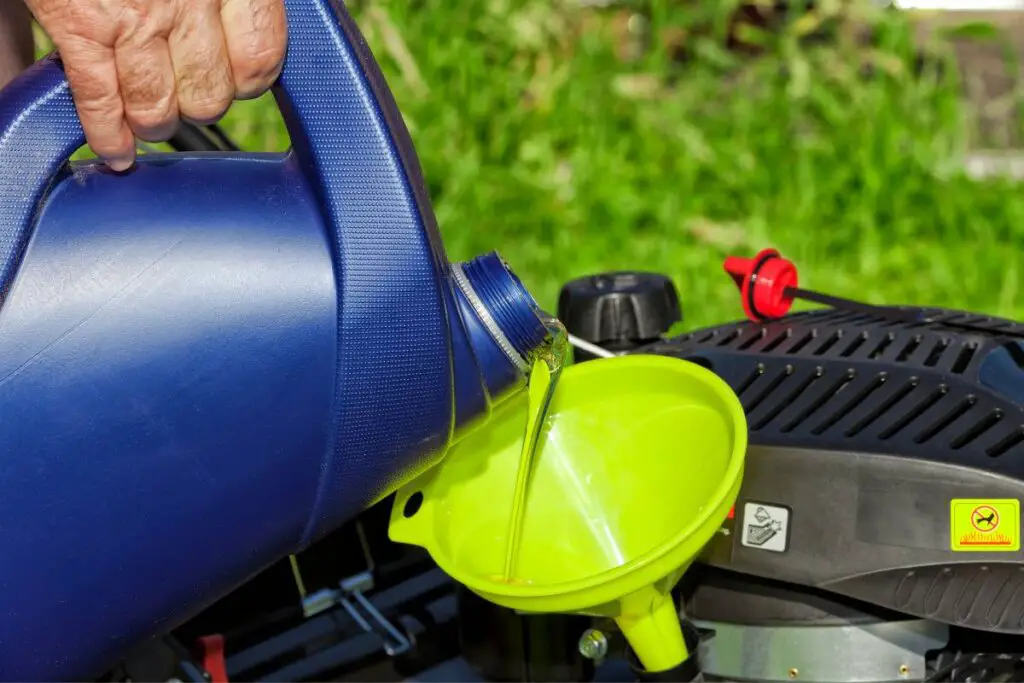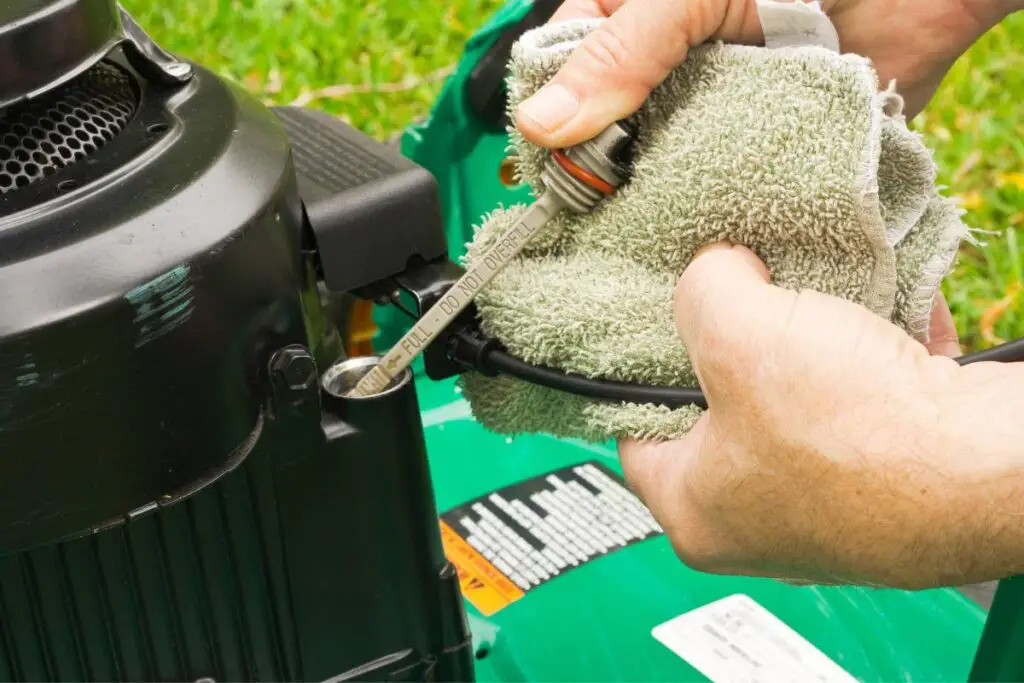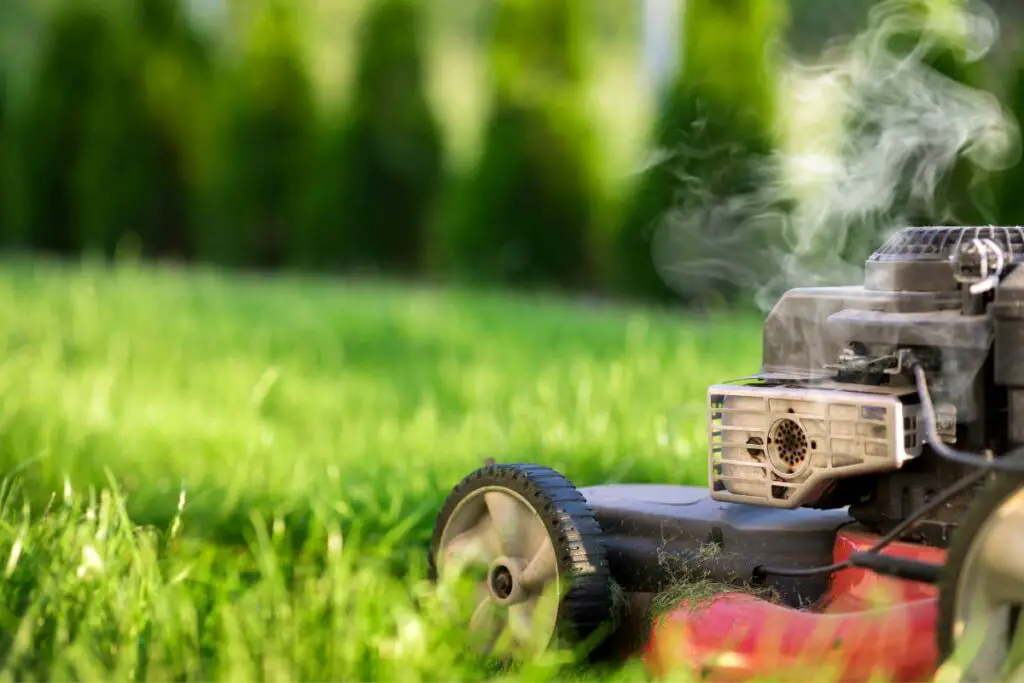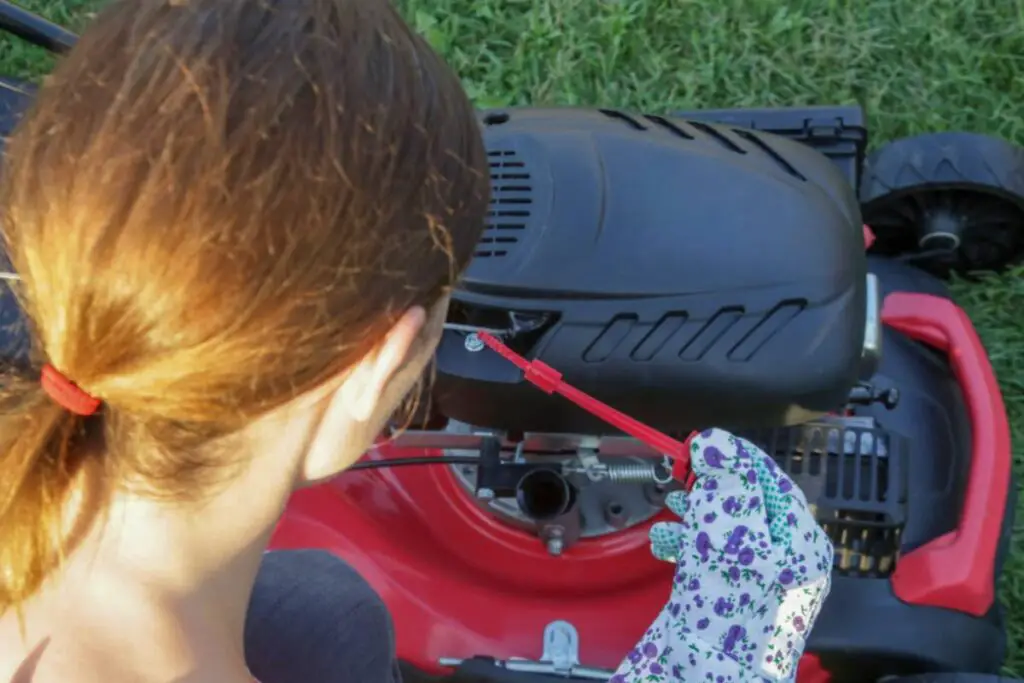If you are a homeowner and your home comprises a lash green lawn, then to maintain it, you will need a lawn mower. But simply mowing the lawn regularly will not suffice. You will also need to maintain your lawn mower. Therefore, you will need to know how to take care of the machine and lubricate the mower as part of the maintenance.
If you overfill your mower with oil, it will likely damage the engine seal. Then when the engine is running, the oil will suck excess air(aerate) and not lubricate well, possibly causing engine failure. The oil can also pump into the airbox, which damages the air filter, causing engine smoke and stalling.
In this article, I will help you understand what happens when you overfill the oil in your lawn mower. I will discuss all the possible consequences and help you with tips to tackle the situation. So, please keep reading to know more about it.

What will happen if too much oil is added to the mower?
You are in a bit of a hurry and have added excess oil to the mower, and you might think it is fine.
It is just oil, isn’t it? No.
Suppose you will read the user’s manual from the manufacturer.
In that case, you will notice a guideline for adding engine oil to the mower, and the limit is mentioned there.
If the limit is exceeded, it can cause several issues to the engine and damage it significantly.
Below are some issues that you can come across:
- Engine damage.
- Reduced performance
- Oil leakage
- Fire hazard
- Damaged lawn mower parts
- The longevity of the lawn mower is reduced
- Mower not starting
- Repairs and replacements required
Let us discuss in detail each of these issues:
Can high oil levels damage the lawn mower engine?

The engine is undoubtedly the most important part of the mower.
If you pour too much oil into the engine, it can severely damage its components.
The excess foam formed can create friction and can damage the piston, bearing, and crankshaft.
Let us understand how the engine can be affected:
1. Overheating
The lawnmower engine will overheat if more than recommended oil is added to the engine.
Overheating can cause some serious damage to the seals, gaskets, air filters, and combustion chambers.
If the engine’s components get damaged, the mower can stop working.
And the worst thing that can happen to you is the engine can catch fire.
2. Engine Seal damage
If very hot lubricant goes through the oil filter, chances are that the engine seal will get damaged.
This will cause the machine to stop working in a proper manner leading to bigger problems.
3. Engine smoke

Overheated oil can cause white smoke through the combustion chamber.
It is also a common problem when you overfill the mower with oil.
4. The engine is getting locked up
Due to overfilling, the engine can get hydro-locked.
It means the oil can get into the cylinders and restrict the pistons from moving.
This can result in engine damage and can prove costly.
5. Hot engine can blow gaskets
Once, I was mowing for a bit too long, and the engine got red hot.
That is when I noticed that the gaskets were losing their shape.
Had I not stopped the engine on time, the gaskets could have been blown away.
High temperatures can cause some gasket materials to melt or lose shape.
The oil can leak significantly if the gaskets are damaged, and the engine can get damaged.
If the gaskets are blown away, it can also damage the muffler.
Also read: 11 Reasons Your Lawn Mower Is Losing Power(+Quick Fix)
Reduced performance
The overall performance of your lawn mower can deteriorate with overfilling of oil.
With different parts of the engine affected, the RPM is also impacted by a slow-starting motor.
Reduced RPM of the engine can hinder the grass-cutting process.
The mowing will be impacted, and you might not get the desired result.
Leakage of the oil
Overfilling the mower with oil can cause leakage, which can be dangerous for you.
Oil leakage can cause fire hazards, which is why it is very risky.
Even small amounts of oil can cause accidents.
The mower can stop working if enough oil seeps through to other parts due to leakage.
Leaking oil can also cause slippery surfaces, which can again cause accidents.
If the oil spills out into the lawn, it can contaminate the soil too.
Looking for gardening supplies? We have tested 100's of products before recommending them to you guys. Check out our best pick below:
| Image | Gardening Supplies | Best Price? |
|---|---|---|
 Top
Top Top
Top | Raised Garden Bed Kit | Check On Amazon |
 | XLUX Soil Moisture Meter, Plant Water Monitor, Soil Hygrometer Sensor for Gardening, Farming, Indoor and Outdoor Plants, No Batteries Required | No Results |
 Top
Top Top
Top | 82 Pcs Garden Tools Set and Extra Succulent Tools Set | Check On Amazon |
 | Joeys Garden Expandable Garden Hose with 8 Function Hose Nozzle, Lightweight Anti-Kink Flexible Garden Hoses, Extra Strength Fabric with Double Latex Core, (50 FT, Black) | No Results |
 Top
Top Top
Top | Dual Chamber Compost Tumbler | Check On Amazon |
 Top
Top Top
Top | Sunnyglade Plant Stakes | Check On Amazon |
 Top
Top Top
Top | Organic Cold Pressed Neem Seed Oil | Check On Amazon |
 Top
Top Top
Top | Mighty Mint Gallon :-Insect and Pest Control Peppermint Oil | Check On Amazon |
 Top
Top Top
Top | Scotts DiseaseEx Lawn Fungicide | Check On Amazon |
 Top
Top Top
Top | Jacks Classic 20-20-20 All Purpose Fertilizer | Check On Amazon |
 Top
Top Top
Top | 30,000 Seeds Pollinator Attracting Wildflower Mixture | Check On Amazon |
 Top
Top Top
Top | Survival Vegetable Seeds Garden Kit-Over 16,000 Seeds | Check On Amazon |
Fire hazard
Fire hazard is another issue due to oil overfilling.
An overheated engine can catch fire with an excess of oil.
If proper care is not taken, it can be fatal.
Damaged lawn mower parts
Too much oil can hurt the overall machinery of the mower.
You might see the engine malfunctioning.
The spark plug might not work properly and can get damaged due to oil.
If the spark plug misfires, the spark plug wire can also get damaged.
The valve port can also get blocked due to an oil spill.
There can also be white smoke from the engine due to heating-up issues.
All these can cause a hard start for the engine and affect different parts of the mower leading to bigger problems.
The longevity of the mower is reduced.
Overfilling the oil can put extra pressure on the engine and all the mower parts.
Due to this, the longevity of the mower will be reduced.
So, check for white smoke and a humming sound from the engine.
If you get any, then immediately stop and inspect if any issue occurred.
Mower not starting
Too much oil can stop your mower from starting.
The engine will not turn on if oil seeps into the carburetor and the spark plug.
Also, if the crankshaft sinks, oil can get inside the cylinder, and the engine can get hydro locked, and then it will not be possible for the engine to start.
This might need professional help to get it up and running again.
To fix this, you will need to remove the spark plug.
Removing the spark plug can solve the hydro locking issue.
You can then drain the excess oil.
Clean the spark plug with a cleaning solution and sandpaper if required.
Check all the parts; if they are fine, try to start the engine.
Seek professional help if the mower is not starting.
Repairs and replacements required
Overfilling oil can also be costly as it might need repairs and replacements.
Parts like a spark plug, push rod, crankshaft, and the engine can get damaged severely.
In this case, you will need to clean the oil and dirt from the spark plug and other parts.
You might need repairs and also replacements in the worst case.
How can you remove access oil from your lawn mower?

1. Check Crankcase Area
You will need to check the crankcase area. If there is any oil residue, you will need to wipe it with a towel or clean it with the help of a turkey baster.
You can also use a vacuum cleaner to clean the oil from the crankcase area.
2. Need to drain the oil
You will then need to drain the oil from the mower by first locating the oil drain plug.
Then you will need to place a container or under the drain plug and remove the drain plug with the help of a tool like a wrench.
Proper oil removal from the oil pan is necessary for the mower’s health.
You can also use an oil extractor pump if required.
After removing the plug, you will see the oil has started draining, so wait till it drains out completely.
Then reinstall the drain plug correctly and dispose of the oil properly.
3. Check For Excess Oil Left
After you have drained the oil, check if the oil has spilled in the surrounding area.
If you see any, clean it and dispose of it.
You will need to pour sufficient oil through the fill hole into the mower after it is completely drained.
Don’t forget to check the user’s manual to add adequate oil to the mower.
How to stop overfilling?

I recommend you check the user’s manual before filling the oil to your mower.
You could check online for your mower type if you misplaced the user’s manual.
Usually, it is 3/4th of a quart, i.e. 32 ounces for most of the small push mower’s engines.
If your mower has a v-twin engine, it will usually take nearly 2 quarts of motor oil.
But if you have a mower with a 34 horsepower engine or more, it might need 3 quarts of oil.
If you know the capacity of your mower’s crankcase, you can fill the oil accordingly.
An oil dipstick can help you check how much oil you have poured into the mower.
Final words
It is always better to prevent and prepare rather than repent and repair. While filling oil into your lawn mower, you should be mindful that excess oil can eventually bring trouble to your mower and you.
Therefore, it becomes necessary to know the oil requirement for your mower. Nothing is better than this if you can figure out how much oil you must pour before filling. So, you can first read the user’s manual and then start.
I understand that you might not have the user’s manual. Still, you can always check what is recommended online for your mower’s model. Awareness about the size and capacity of the mower’s crankshaft always helps. Otherwise, you might end up overfilling and damaging the parts of your mower. Surplus lubricant increases the risk of accidents and can be mighty costly.
Can you ruin a lawn mower with too much oil?
Yes, too much oil can damage the push mower engine and the other parts. It also increases the risk of catching fire due to engine overheating.
What happens if you overfill oil in the riding lawn mower?
If the riding lawn mower is overfilled, the oil will start foaming. Instead of lubricating, it will cause friction, which can lead to engine failure.
